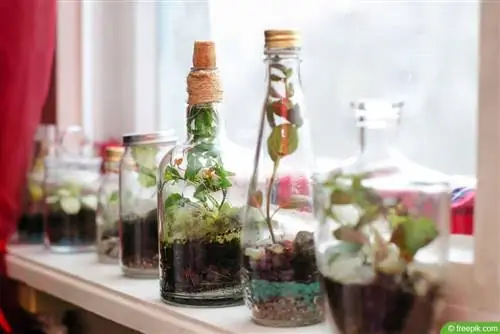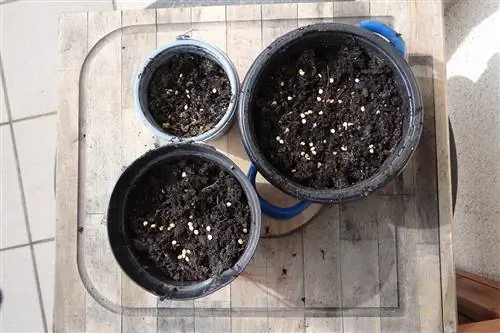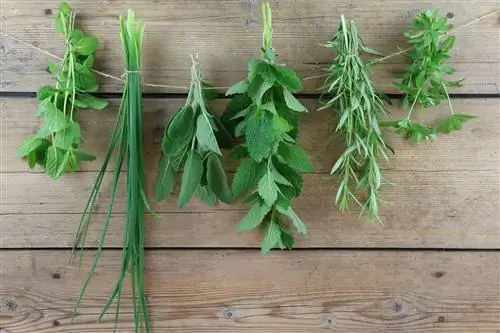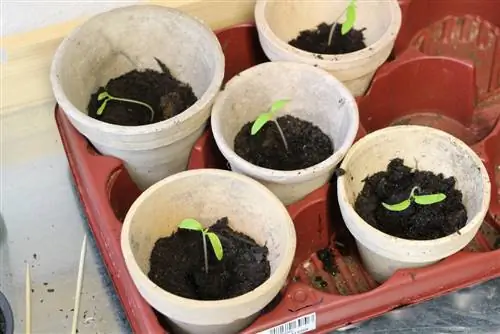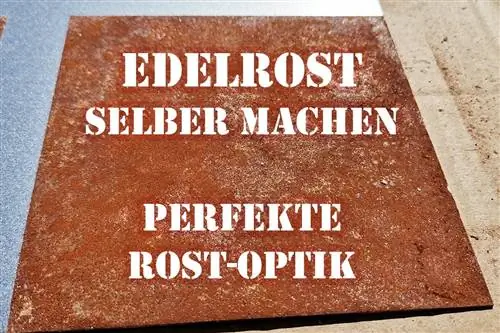- Author admin [email protected].
- Public 2023-12-17 03:39.
- Last modified 2025-01-24 12:45.
A garden in a glass is the ideal way to bring nature into your home. The whole thing is also known as a bottle garden, under the name Hermetosphere or Ecosphere, a special aquarium. There are a few things to consider when setting up and handling such a system. Be it the selection of suitable containers and plants, the composition of the substrate or the correct structure in general.
Mini biosphere in the shape of a bottle garden
An ecosystem in a glass is best known as a bottle garden. It can be created in both open glass containers and closed ones. The latter is called the hermetosphere and is a self-contained ecosystem in the form of a small, sealable glass vessel filled with plants.
The plants absorb water from the substrate and partially evaporate it through their leaves. This forms condensation on the inner walls and drips onto the substrate in the form of rain, where it is available to the plants again. They obtain nutrients from dead plant parts. Plants use photosynthesis to filter carbon dioxide from the air and release oxygen.
Materials needed
- Airtight glass jar
- Capacity of at least two liters
- Low-nutrient substrate
- Lime-free, chemically neutral types of gravel
- Lava granules, expanded clay, pumice stone or soil fillings
- Cuttings or offshoots of suitable plant species
- Cardboard roll or conventional funnel for filling
- Wooden sticks or long tweezers for inserting the plants
- Sieve for washing the stones
The right vessel
When choosing a glass jar, it is important that it is easy to fill. You can use a conventional bottle, but containers with a slightly larger opening are better. They should be bulbous and closeable, with a lid or cork stopper. This is the only way a small ecosystem can emerge.
Vessels with special shapes such as a glass lantern with a practical cord for hanging, classic preserving or candy jars or a decorative bottle with a large opening are ideal.
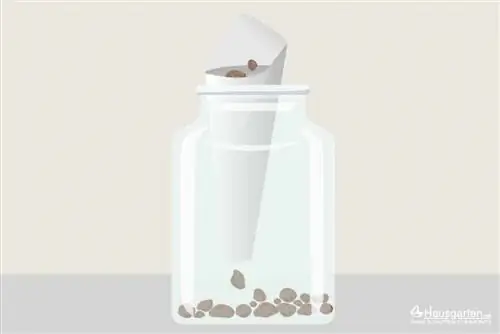
Tip:
Cork closures must be specially sealed beforehand, otherwise they can become moldy.
The perfect substrate
Not every substrate is suitable for planting a bottle garden. Unsuitable substrates, such as conventional potting soil, would mold very quickly. The right substrate is the basis for a functioning mini-biosphere.
- It should be stable, coarse-grained, durable and not compact
- Inorganic materials with a grain size of 2 to 6 mm are optimal
- Airy and dimensionally stable expanded clay as if created
- Bas alt grit and lava granules, thanks to the open, porous structure
- Pumice stone and Akadama, a purely mineral granulate, suitable
-
Substrates like Seramis are completely unsuitable
Material is not dimensionally stable
Can cause unsightly streaks on glass walls
You should also avoid calcareous substrates such as marble gravel, as they could chemically change the environment in the glass. What doesn't work at all is pre-fertilized, commercially available potting soil. It gradually condenses, which hinders gas exchange and can lead to the formation of rot. It also releases nutrients, which leads to undesirably lush plant growth.
Right plant selection
Depending on the shape and size of the glass, slow-growing and small plant species are suitable for planting. They should be robust, tolerate constant moisture and a lack of nutrients, survive without direct sunlight and generally have similar requirements. The climatic conditions in their natural locations should be as similar as possible to those in the glass. Exotic species such as mini orchids from different orchid genera and bromeliads are particularly suitable for a garden in a glass. Mosses such as peat mosses, small ferns, ornamental peppers, zebraweed, mini spider plants, the spiderwort (Tradescantia) and even carnivorous plants also do very well. They should definitely be he althy and pest-free.
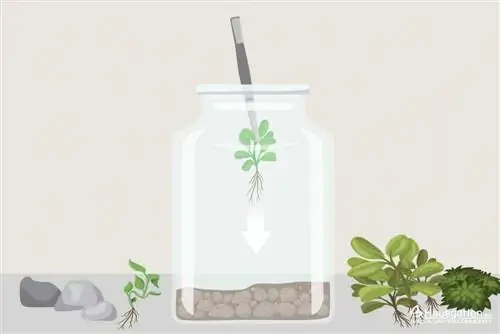
Tip:
Drought-loving cacti and succulents are only suitable for open bottle gardens.
Step-by-step instructions
Before filling, the glass container should be cleaned thoroughly and then rinsed with clear water. Ideally, both the pebbles and the bottle are germ-free. Granules can be rinsed in a sieve with water to remove dust and other dirt. Then you can get started.
Fill drainage
The substrate for the mini ecosystem should support the oxygen supply, ensure a balanced moisture ratio and protect the roots from rot. Therefore it should be perfect. The bottom layer is gravel or coarse-grained granules, preferably expanded clay or lava granules. If the glass opening is slightly smaller, you can use a funnel made of cardboard or a similar filling aid to fill it. The material must be evenly distributed on the floor. Ultimately, this layer should amount to around 10-20 percent of the total height of the glass vessel and should be filled in two stages.
Tip:
A beautiful look can be achieved by using different stones or granules.
Inserting the plants
If you are using potted plants, carefully shake off the soil, if possible without damaging the roots. Of course you can also use cuttings or offshoots of suitable houseplants.
- Rinse roots under running water
- Fill the container with two thirds of the substrate
- Insert and place plants using tweezers or similar
- Then fill in the remaining substrate in a targeted manner
- Best with a funnel
- Roots must be completely covered
- Simply insert cuttings and offshoots between the stones
- Place mosses on the top substrate layer
- If necessary, add some decorative material
- Finally, water lightly with low-lime water, ideally rainwater
- It's best to do it in stages again
- Avoid flooding at all costs
- For smaller vessels it is best to use a pipette
- There should be no water visible or collecting at the bottom
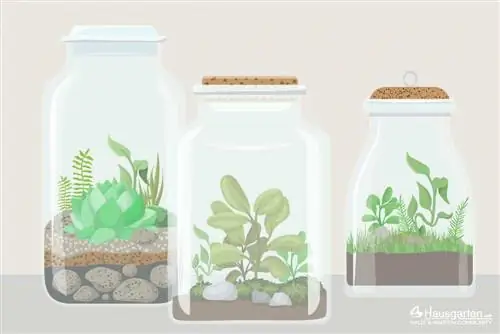
Tip:
With additional decoration you can individually design your own little mini biosphere. You should make sure to only use weather-resistant materials and not wood that is susceptible to decay.
Add decomposers
Indispensable for a functioning ecosystem in mini format and important little helpers are microorganisms. They act as a cleaning crew as well as soil and he alth police as they feed on mold and dead plant parts. Tropical springtails (Collembola) and white woodlice (Trichorhina tomentosa) have proven particularly useful. They cannot live in dry apartment air, but it is completely different in a bottle garden; these light-shy animals feel right at home here. One calculates around 10-15 specimens per liter of vessel volume. Finally, the glass or bottle is closed.
Tip:
If there is too much water in the glass, leave it open for a few days until the excess water has evaporated.
Make sure you have the right location
Light plays a crucial role in location. Although a bright spot is important, direct sunlight should be avoided at all costs. If you don't do this, the burning glass effect can cause the leaves to burn and the temperature in the container to rise quickly to over 40 degrees. This ruins the most beautiful bottle garden. Ideal locations are a north, northeast or northwest window or a bright, sunny place within the apartment. A location without natural daylight is also possible. However, artificial lighting must then be provided for around twelve hours a day.
Caring for the mini biosphere
An ecosystem in a glass is generally self-sustaining. The fact that the whole thing works is shown, among other things, by the fact that the inner glass walls are misted up in the morning and dry out over the course of the day. If this is not the case, it is advisable to open the glass jar briefly and allow excess moisture to escape. By the way, you should also open it if you see sick or rotting plants and then remove them.
Ecosystem in the form of an Ecosphere
In addition to the traditional bottle garden, there is also the so-called Ecosphere. This is a special aquarium whose inhabitants, such as mini shrimps, snails and bacteria, are enclosed in a closed glass vessel for years without external influences. A self-contained, self-sufficient ecosystem and small underwater paradise. All it needs is some indirect sunlight and consistent temperatures.

The difference to the mini biosphere or hermetosphere described above is that the container is filled with water, like any other aquarium. An Ecosphere requires 6-12 hours of sunlight and room temperatures between 15 and 30 degrees.
How it works
- Algae absorb nutrient s alts from the water
- Produce oxygen using sunlight
- Shrimps absorb oxygen
- They then release carbon dioxide
- This is what algae use for photosynthesis
- Bacteria convert shrimp excretions into dead material and nutrient s alts
- They feed the algae
- Algae and bacteria serve as a food source for shrimp
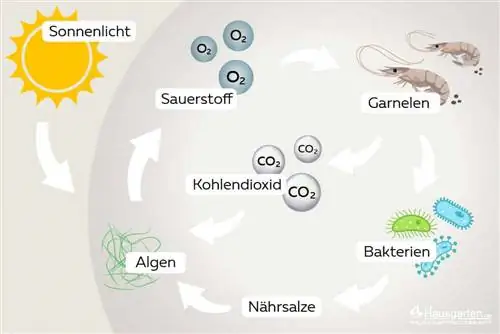
However, this form of aquarium keeping is controversial because keeping animals in closed vessels is not optimal. Especially for shrimp species that are not adapted to life in such an environment. They would probably die relatively quickly. These little animals have neither a lot of space nor enough places to hide. This is especially true for smaller glass containers.

